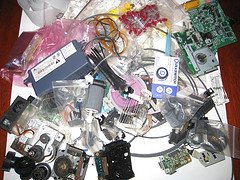After getting GPSDrive running on OS X I started looking into different sources for maps. The GPSDrive wiki has a couple of interesting pages about this: one on creating maps and one on map sources. The second page pointed me to the LibreMap Project which has a complete collection of  USGS 1:24000 (large scale) topographic maps for the entire US. These files are distributed as high-resolution GeoTIFF files, along with world files, so the maps are fully geotagged. This means that they contain all of the information needed to generate GPSDrive-friendly map tiles, but GPSDrive will not read them directly. The creating maps page gives some (heavily out-of-date) advice on how to use the gdal_slice.sh script distributed with GPSDrive to create map tiles using the tools from GDAL. Sadly, this script is completely unusable on OS X, because of incompatibilities in the command line tools that are used by the shell script. After spending about five minutes trying to tune it to work with the tools that Apple ships, I completely gave up and looked into other approaches.
Luckily, I quickly found out that GDAL ships with Python bindings. I installed GDAL from source using the instructions from their wiki. To make sure it built with Python modules I ran ./configure –with-python. After that make and sudo make install ran without a hitch.
I then set about re-implementing gdal_slice.sh in Python. Once I got a handle on how to use the Python bindings it was fairly easy to write. You can find the script here.
Using gdal_slice.py is very similar to using gdal_slice.sh:
$ ./gdal_slice.py -h
Usage: gdal_slice.py [options] FILENAME
Options:
-h, --help show this help message and exit
-o OVERLAP, --overlap=OVERLAP
percentage tiles will overlap. should be at least 20%
-a, --add write map info to map_koord.txt in current working
directory
-m, --map use *_map folders for output; use if input image is
UTM. Default behavior
-t, --topo use *_top folders for output; use if input image is
not UTM
-v, --verbose enable debugging output
The biggest difference is that gdal_slice.py does not perform any format conversion; it will write maps to TIFF files. Although the file size is decidedly larger than that of PNGs, my version of GDAL is unable to create PNGs, and disk space is (fairly) cheap. If I’m motivated I’ll get around to adding a format option, at least to allow conversion to PNG.
Running gdal_slice.py filename.ext will create a folder named filename_map (or _top, if you use the -t flag) that contains a set of 1280×1024 TIFF files, as well as a map_koord_draft.txt file. Moving this folder into GPSDrive’s map directory, and merging filename_[map|top]/map_koord_draft.txt with map_koord.txt will make the new maps available to GPSDrive. Note that filename.ext must be in the current working directory, as the script handles filenames/paths somewhat naivëly.
So far I’ve only tested this with GeoTIFFs from LibreMaps, but it seems to work great, with the caveat that LibreMaps’ files include the borders of map, and my script doesn’t do any cropping, so you see borders if you’re near the edges of quads. This doesn’t bother me terribly much, but you may need to turn mapsets on and off in the Map Control dialog to see the appropriate images.
Update 7-14-11: I’ve modified the script with an additional flag (-a) that will automatically merge the generated map_koords file with map_koord.txt in the current working directory. This means that if you run the script from inside .gpsdrive/maps with the -a flag the generated tiles will be automatically added to GPSDrive’s database. The script avoids creating duplicate entries in map_koord.txt, as well as alphabetizing all entries.
I’ve modified the documentation here, as well as the links, to reference the latest version.



 Guess what? MoveOn.Org is giving out FREE Obama buttons!
Guess what? MoveOn.Org is giving out FREE Obama buttons!